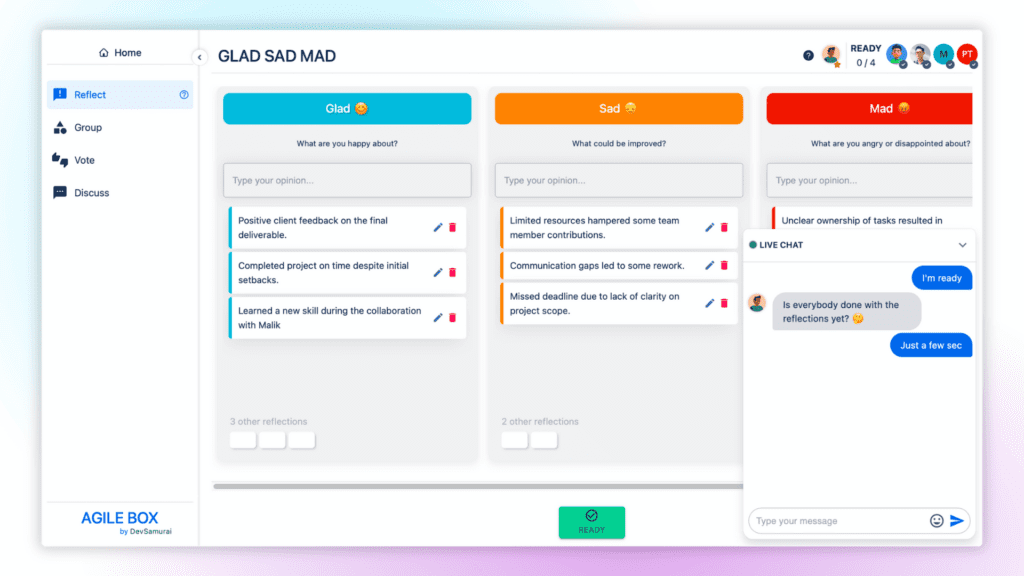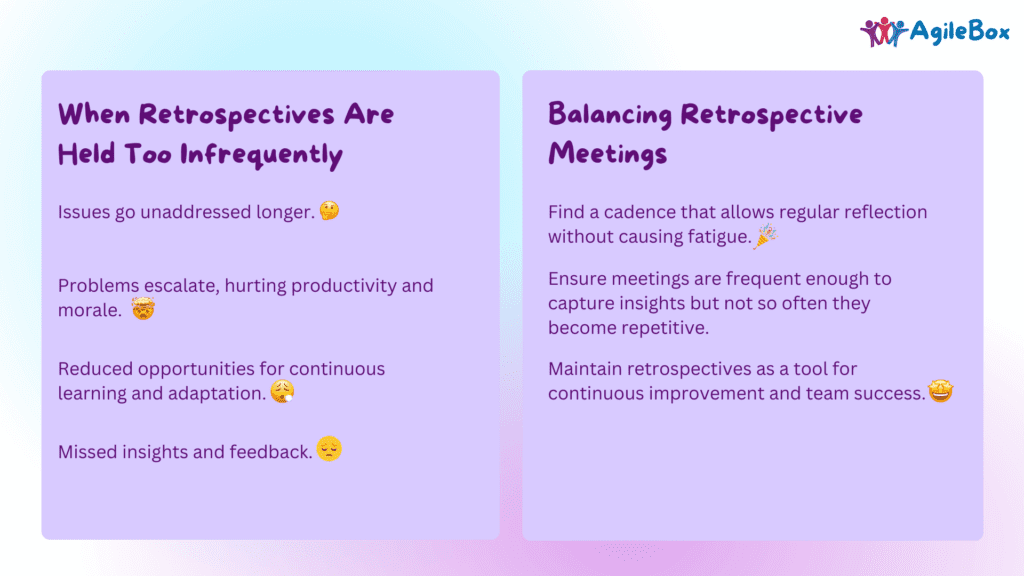Sprint retrospectives are a cornerstone of agile methodologies, providing teams with a structured opportunity to reflect on their recent work and identify improvements. By regularly examining what went well, what didn’t, and how processes can be enhanced, teams can continuously evolve and enhance their productivity and collaboration. But how often should these retrospectives be held to maximize their effectiveness without overwhelming the team? In this blog, we’ll explore the optimal frequency for sprint retrospectives, considering various factors such as team dynamics, sprint length, and the balance between reflection and action.
But First What is Sprint Retrospective?
A Sprint Retrospective is a meeting held at the end of a sprint in Agile methodologies, primarily Scrum, where the team reflects on their work process. It is an essential practice aimed at continuous improvement.
Purpose of a Sprint Retrospective
The primary goals of a Sprint Retrospective are to:
- Reflect on the Sprint: Team members discuss and analyze the sprint’s outcomes and their workflow.
- Identify Improvements: Pinpoint areas where the team can improve their processes or practices.
- Develop Actionable Plans: Create concrete steps to implement improvements in the next sprint.
Structure of a Sprint Retrospective
A typical Sprint Retrospective follows a structured format to ensure productive and focused discussions. Here’s a common approach:
- Set the Stage: The facilitator, often the Scrum Master, sets the tone for the meeting, ensuring a safe environment for open and honest discussion.
- Gather Data: Team members share observations about what happened during the sprint, focusing on both successes and challenges.
- Generate Insights: The team analyzes the gathered data to uncover patterns, root causes, and potential areas for improvement.
- Decide What to Do: The team prioritizes the identified improvements and develops a plan to implement changes in the next sprint.
- Close the Retrospective: The facilitator wraps up the meeting, often summarizing the key takeaways and action items.
When is a Sprint Retrospective Held?
A sprint retrospective is typically held at the end of each sprint. In agile methodologies, a sprint is a set period during which specific work has to be completed and made ready for review. The duration of a sprint can vary, but it commonly lasts between one to four weeks.
The sprint retrospective is scheduled after the sprint review and before the next sprint planning meeting. This timing ensures that the team can reflect on the recently completed sprint while the experiences are still fresh, allowing them to identify what went well, what could be improved, and actionable steps for the next sprint. Holding the retrospective at the end of each sprint ensures that the team can make continuous improvements, fostering an environment of constant learning and adaptation.
Benefits of a Sprint Retrospective
Sprint Retrospectives offer numerous benefits that significantly enhance team performance and dynamics. Regular retrospectives promote a culture of continuous improvement, allowing teams to adapt and refine their processes over time. These meetings foster better communication and collaboration within the team, ensuring that everyone’s voice is heard, which leads to more cohesive and effective teamwork. By promptly addressing and resolving issues, teams can increase their efficiency and productivity in future sprints. Additionally, acknowledging successes and collectively working through challenges boosts team morale and motivation, creating a more positive and productive work environment.
→ Related article: Understanding Highlight and lowlight retrospectives
So Why Do Teams Run Sprint Retrospectives?
Moreover, sprint retrospectives are crucial for fostering continuous improvement within a team. They provide a dedicated time and space for team members to reflect on their performance, both individually and collectively. During these meetings, the team discusses what went well, what didn’t, and how processes can be enhanced moving forward.
Additionally, retrospectives help build a culture of open communication and trust. Team members can voice their concerns, share insights, and suggest improvements without fear of judgment. This open dialogue encourages collaboration and innovation, as everyone’s perspectives are valued.
Furthermore, retrospectives allow teams to identify and address issues before they become significant problems. By regularly reviewing and refining their processes, teams can adapt to changing circumstances and improve their efficiency and effectiveness. This proactive approach helps maintain momentum and ensures that the team is always striving for excellence.

How Long Should My Sprints Be?
Consequently, the length of your sprints plays a significant role in determining the frequency of your retrospectives. Typically, sprint durations range from one to four weeks, and this duration impacts the rhythm of your team’s workflow and the cadence of retrospectives.
Shorter sprints, such as one or two weeks, offer the advantage of more frequent retrospectives. This allows the team to quickly identify and address issues, making iterative improvements in a shorter time frame. However, the downside is that frequent retrospectives can become repetitive and time-consuming if not managed well.
On the other hand, longer sprints, such as three or four weeks, provide more time for the team to work on substantial tasks and see the results of their efforts. The retrospectives are less frequent, which can help prevent meeting fatigue. However, the risk is that issues may persist longer before being addressed, potentially impacting the team’s performance and morale.
Therefore, finding the right balance is crucial. Teams should experiment with different sprint lengths to see what works best for them, considering factors like project complexity, team size, and workflow dynamics. The key is to ensure that retrospectives remain productive and valuable, driving continuous improvement without overwhelming the team.
What Happens When Retrospectives Are Too Frequent or Infrequent?
However, the frequency of sprint retrospectives can significantly influence their effectiveness and the team’s overall performance. When retrospectives are held too frequently, such as after very short sprints, the meetings can become repetitive and lose their impact. Team members may feel that there isn’t enough new information or changes to discuss, leading to disengagement and a lack of enthusiasm for the process. This can ultimately reduce the value of the retrospectives and hinder the team’s ability to make meaningful improvements.
Conversely, when retrospectives are held too infrequently, important issues might go unaddressed for longer periods. Problems that could have been identified and resolved early may escalate, affecting the team’s productivity and morale. Infrequent retrospectives also reduce the opportunities for continuous learning and adaptation, which are core principles of agile methodologies. The team might miss out on valuable insights and feedback that could help them refine their processes and improve performance.
Therefore, striking the right balance in the frequency of retrospectives is crucial. Teams need to find a cadence that allows for regular reflection and improvement without causing meeting fatigue or missing out on critical opportunities for growth. This balance ensures that retrospectives remain a powerful tool for fostering continuous improvement and driving the team’s success.

Final Words
In conclusion, the frequency and quality of sprint retrospectives are vital to an agile team’s success. Holding retrospectives at the end of each sprint, whether it’s one to four weeks long, allows teams to reflect on their performance, identify areas for improvement, and make necessary adjustments. However, the frequency of these retrospectives should strike a balance to avoid the pitfalls of being too frequent or too infrequent.
Moreover, data and industry practices suggest that the duration of retrospectives should be proportional to the sprint length, and varying the format can keep these sessions engaging and productive. By adhering to these guidelines, teams can ensure that their retrospectives remain a powerful tool for continuous improvement, fostering better communication, collaboration, and overall performance.
Ultimately, the goal of sprint retrospectives is to create a culture of continuous learning and adaptation, where teams can thrive and deliver their best work consistently. By fine-tuning the frequency and approach to retrospectives, agile teams can maximize their potential and achieve sustained success.
→ Try out planning poker for Jira by AgileBox



